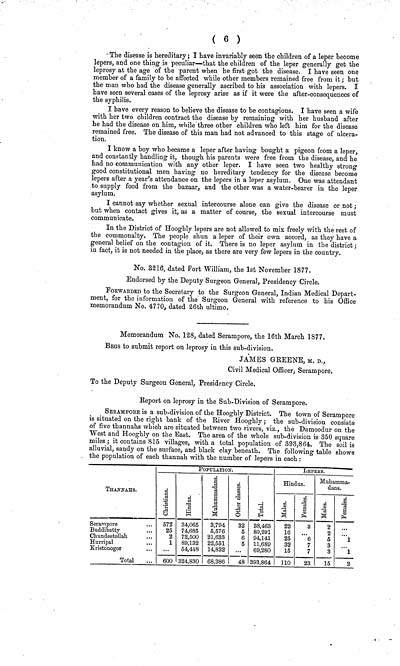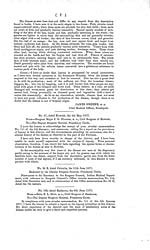Download files
Individual page:
Thumbnail gallery: Grid view | List view

( 6 )
The disease is hereditary; I have invariably seen the children of a leper become
lepers, and one thing is peculiar-that the children of the leper generally get the
leprosy at the age of the parent when he first got the disease. I have seen one
member of a family to be affected while other members remained free from it ; but
the man who had the disease generally ascribed to his association with lepers. I
have seen several cases of the leprosy arise as if it were the after-consequences of
the syphilis.
I have every reason to believe the disease to be contagious. I have seen a wife
with her two children contract the disease by remaining with her husband after
he had the disease on him, while three other children who left him for the disease
remained free. The disease of this man had not advanced to this stage of ulcera-
tion.
I know a boy who became a leper after having bought a pigeon from a leper,
and constantly handling it, though his parents were free from the disease, and he
had no communication with any other leper. I have seen two healthy strong
good constitutional men having no hereditary tendency for the disease become
lepers after a year's attendance on the lepers in a leper asylum. One was attendant
to supply food from the bazaar, and the other was a water-bearer in the leper
asylum.
I cannot say whether sexual intercourse alone can give the disease or not;
but when contact gives it, as a matter of course, the sexual intercourse must
communicate.
In the District of Hooghly lepers are not allowed to mix freely with the rest of
the commonalty. The people shun a leper of their own accord, as they have a
general belief on the contagion of it. There is no leper asylum in the district;
in fact, it is not needed in the place, as there are very few lepers in the country.
No. 3216, dated Fort William, the 1st November 1877.
Endorsed by the Deputy Surgeon General, Presidency Circle.
FORWARDED to the Secretary to the Surgeon General, Indian Medical Depart-
ment, for the information of the Surgeon General with reference to his Office
memorandum No. 4770, dated 26th ultimo.
Memorandum No. 128, dated Serampore, the 16th March 1877.
BEGS to submit report on leprosy in this sub-division.
JAMES GREENE, M. D.,
Civil Medical Officer, Serampore.
To the Deputy Surgeon General, Presidency Circle.
Report on leprosy in the Sub-Division of Serampore.
SERAMPORE is a sub-division of the Hooghly District. The town of Serampore
is situated on the right bank of the River Hooghly; the sub-division consists
of five thannahs which are situated between two rivers, viz., the Damoodur on the
West and Hooghly on the East. The area of the whole sub-division is 350 square
miles ; it contains 815 villages, with a total population of 393,864. The soil is
alluvial, sandy on the surface, and black clay beneath. The following table shows
the population of each thannah with the number of lepers in each :
POPULATION.
LEPERS.
THANNAHS.
Christians.
Hindus.
Muhammadans.
Other classes.
Total.
Hindus.
Muhammadans.
Males.
Females.
Males.
Females.
Serampore
572
34,065
3,794
32
38,463
22
3
2
...
Buddibatty
25
74,685
5,576
5
80,291
16
...
2
...
Chundeetollah
2
72,500
21,633
6
94,141
25
6
5
1
Hurripal
1
89,132
22,551
5
11,689
32
7
3
...
Kristonogor
...
54,448
14,832
...
69,280
15
7
3
1
Total
600
324,830
68,386
48
393,864
110
23
15
2
The disease is hereditary; I have invariably seen the children of a leper become
lepers, and one thing is peculiar-that the children of the leper generally get the
leprosy at the age of the parent when he first got the disease. I have seen one
member of a family to be affected while other members remained free from it ; but
the man who had the disease generally ascribed to his association with lepers. I
have seen several cases of the leprosy arise as if it were the after-consequences of
the syphilis.
I have every reason to believe the disease to be contagious. I have seen a wife
with her two children contract the disease by remaining with her husband after
he had the disease on him, while three other children who left him for the disease
remained free. The disease of this man had not advanced to this stage of ulcera-
tion.
I know a boy who became a leper after having bought a pigeon from a leper,
and constantly handling it, though his parents were free from the disease, and he
had no communication with any other leper. I have seen two healthy strong
good constitutional men having no hereditary tendency for the disease become
lepers after a year's attendance on the lepers in a leper asylum. One was attendant
to supply food from the bazaar, and the other was a water-bearer in the leper
asylum.
I cannot say whether sexual intercourse alone can give the disease or not;
but when contact gives it, as a matter of course, the sexual intercourse must
communicate.
In the District of Hooghly lepers are not allowed to mix freely with the rest of
the commonalty. The people shun a leper of their own accord, as they have a
general belief on the contagion of it. There is no leper asylum in the district;
in fact, it is not needed in the place, as there are very few lepers in the country.
No. 3216, dated Fort William, the 1st November 1877.
Endorsed by the Deputy Surgeon General, Presidency Circle.
FORWARDED to the Secretary to the Surgeon General, Indian Medical Depart-
ment, for the information of the Surgeon General with reference to his Office
memorandum No. 4770, dated 26th ultimo.
Memorandum No. 128, dated Serampore, the 16th March 1877.
BEGS to submit report on leprosy in this sub-division.
JAMES GREENE, M. D.,
Civil Medical Officer, Serampore.
To the Deputy Surgeon General, Presidency Circle.
Report on leprosy in the Sub-Division of Serampore.
SERAMPORE is a sub-division of the Hooghly District. The town of Serampore
is situated on the right bank of the River Hooghly; the sub-division consists
of five thannahs which are situated between two rivers, viz., the Damoodur on the
West and Hooghly on the East. The area of the whole sub-division is 350 square
miles ; it contains 815 villages, with a total population of 393,864. The soil is
alluvial, sandy on the surface, and black clay beneath. The following table shows
the population of each thannah with the number of lepers in each :
POPULATION.
LEPERS.
THANNAHS.
Christians.
Hindus.
Muhammadans.
Other classes.
Total.
Hindus.
Muhammadans.
Males.
Females.
Males.
Females.
Serampore
572
34,065
3,794
32
38,463
22
3
2
...
Buddibatty
25
74,685
5,576
5
80,291
16
...
2
...
Chundeetollah
2
72,500
21,633
6
94,141
25
6
5
1
Hurripal
1
89,132
22,551
5
11,689
32
7
3
...
Kristonogor
...
54,448
14,832
...
69,280
15
7
3
1
Total
600
324,830
68,386
48
393,864
110
23
15
2
Set display mode to: Large image | Zoom image | Transcription
Images and transcriptions on this page, including medium image downloads, may be used under the Creative Commons Attribution 4.0 International Licence unless otherwise stated. ![]()
| India Papers > Medicine - Disease > Distribution and causation of leprosy in British India 1875 > (51) Page 6 |
|---|
| Permanent URL | https://digital.nls.uk/74506402 |
|---|




